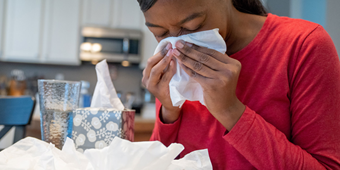EpiPen: Your Lifesaving Superhero

Answer a few questions and we'll provide you with a list of primary care providers that best fit your needs.
Are you or a loved one at risk of a serious, life-threatening allergic reaction? If so, an EpiPen could save your life.
This very serious allergic reaction is called anaphylaxis. It involves more than one part of the body, such as the skin, respiratory and gastrointestinal systems. EpiPens contain an injectable dose of epinephrine. This is the only medicine that can reverse the symptoms of anaphylaxis.
If you have allergies or asthma and have a family history of anaphylaxis, your risk is higher, says the American Academy of Allergy, Asthma & Immunology. And if you’ve experienced anaphylaxis in the past, your risk of having another anaphylactic reaction increases.
If you, your child or another family member fit these categories, you can take steps to manage allergic reactions and be prepared in the case of an emergency.
 What Is Anaphylaxis?
What Is Anaphylaxis?
The severe reactions of anaphylaxis are caused by foods, medicines, stinging insects and latex. According to the American Academy of Pediatrics, common causes of anaphylaxis are:
Foods such as peanuts, tree nuts, shellfish, fish, milk and eggs.
Insect bites or stings from bees, wasps, hornets, yellow jackets and fire ants.
Medicines, such as antibiotics, anti-seizure medicines, aspirin and non-steroidal anti-inflammatory medications.
What makes anaphylaxis more dangerous than a typical allergic reaction is the way your body reacts to the allergens. Normally, your body’s immune system overreacts to an allergen by releasing chemicals that cause allergy symptoms. In some people, this reaction affects more than one part of the body at the same time.
When this happens, immediate medical treatment is needed. The most severe reactions restrict breathing and blood circulation. If not treated properly, anaphylaxis can be fatal, says the American Academy of Allergy, Asthma & Immunology.
Anaphylaxis can begin within minutes of contact or may not appear for an hour. Symptoms and the parts of the body they affect include:
- Skin: Itching, hives, redness, swelling
- Nose: Sneezing, stuffy nose, runny nose
- Mouth: Itching, swelling of the lips or tongue
- Throat: Itching, tightness, difficulty swallowing, swelling of the back of the throat
- Chest: Shortness of breath, cough, wheeze, chest pain, tightness
- Heart: Weak pulse, passing out, shock
- Gastrointestinal (GI) tract: Vomiting, diarrhea, cramps
- Nervous system: Dizziness or fainting, feeling of doom
When anaphylaxis begins, treatment with epinephrine should be given right away, followed by a trip to the emergency room, says the National Institute of Allergy and Infectious Diseases.
Epinephrine and Other Treatments
Epinephrine comes in a single dose, pre-filled automatic injection device (EpiPen) that is to be injected into the outer thigh. Epinephrine works immediately but does not last long in the body. A repeat dose or doses may be needed.
After you administer an epinephrine injection to yourself, your child or a family member, call 911. Request an ambulance and tell the dispatchers that epinephrine was used.
Even if symptoms start to go away, you should always go to the emergency room for further treatment, says the nonprofit research group Food Allergy Research & Education.
What makes anaphylaxis more dangerous than a typical allergic reaction is the way your body reacts to the allergens.
Depending on the severity of your anaphylactic reaction, emergency room health care professionals may also provide secondary treatments, such as:
- Asthma and other medicines to open the airways
- Antihistamines to relieve itching and hives
- Corticosteroids to prevent inflammation and long-lasting reactions
- Additional medicines to constrict blood vessels and increase heart rate
- Supplemental oxygen therapy
- Intravenous fluids
How to Use an EpiPen
If you or a loved one is at risk for a severe allergic reaction, always carry two doses of an epinephrine auto-injector with you and inform others about your risks.
Be sure to work with your doctor and an allergy specialist to identify what triggered your reaction so that you can avoid it in the future. Make sure you and family members receive training on how to use the EpiPen.
If your child is highly allergic and his old enough to learn how, teach him or her the right way to give the injection to themselves.
Follow these tips to keep you and your family safe in the case of anaphylaxis.
Know how to use your EpiPen:
- Practice using the auto-injector until the process becomes second nature.
- Teach others how to use the EpiPen.
- Give the injection in the outer thigh.
- It’s OK to use the EpiPen through clothing.
- Be sure to hold the EpiPen in place long enough to deliver all of the medicine.
- Check and follow the manufacturer’s website for detailed instructions on using the EpiPen.
- Go to the emergency room for further treatment after using an EpiPen.
Carrying and storing epinephrine:
- Keep the EpiPen out of direct light.
- Store at room temperature.
- Do not refrigerate the EpiPen.
- Do not freeze the EpiPen.
- Do not store the EpiPen in a vehicle.
- Regularly check the epinephrine solution for discoloration. A pink or yellow color may mean the epinephrine is no longer effective.
Managing an EpiPen for your child:
- Teach your child how to self-administer the EpiPen.
- Teach your child to recognize the early signs of an allergic reaction.
- Always carry at least two doses.
- Keep two doses of epinephrine at your child’s school, with instructions from their doctor on how and when to use it.
The National Institute of Allergy and Infectious Diseases recommends creating an anaphylaxis emergency action plan with your doctor. If you experience anaphylaxis or even think that you are, use your EpiPen right away and seek immediate medical attention.
Answer a few questions and we'll provide you with a list of primary care providers that best fit your needs.
Source: American Academy of Allergy Asthma & Immunology, American Academy of Pediatrics, National Institute of Allergy and Infectious Diseases, Food Allergy Research & Education




